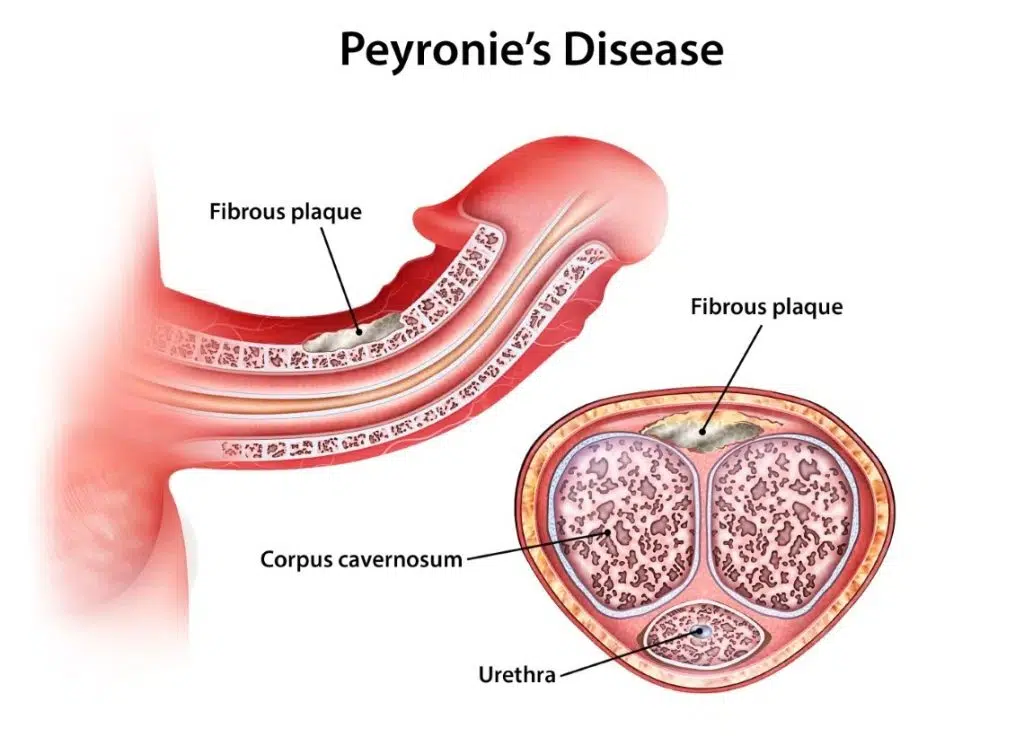- 10 November 2025
- Mr. Leon Almashan
Last updated on November 10, 2025
For men diagnosed with Peyronie’s disease, one of the most pressing questions is: Is Peyronie’s disease permanent? While some medical literature cites spontaneous improvement in a small percentage of cases (around 15%), clinical experience tells a different story. At MansMatters, genuine resolution without treatment is seen in less than 1% of cases.
This distinction is critical. Pain associated with the acute phase of Peyronie’s often eases over time, which can create the impression that the disease is “going away.” In reality, the underlying scar tissue and curvature almost always remain, and the condition progresses into a stable but chronic stage.
Peyronie’s disease should therefore be regarded as a long-term condition that does not resolve on its own. Understanding this outlook is essential for setting realistic expectations and ensuring men do not delay seeking appropriate support.
Table of Contents
ToggleWhat Is Peyronie’s Disease?
Peyronie’s disease is a penile curvature condition caused by scar tissue (plaques) forming inside the penis. This fibrous tissue can create:
- A noticeable curve or bend during erections
- Localised lumps or hard patches
- Pain in the acute stage
- Changes in erectile function
- Decrease in sensitivity
- Indentation or other forms of deformity
The condition is usually described in two phases:
- Acute (active) phase: where scar tissue is developing, pain may occur and curvature can worsen.
- Stable (chronic) phase: where pain often eases, but the curve and deformity typically remain.

Can Peyronie’s Disease Go Away on Its Own?
The belief that Peyronie’s disease might resolve without treatment usually comes from two factors: research papers reporting spontaneous improvement in a small minority of men and the natural reduction in pain as the disease shifts from the acute to the stable phase.
These points, however, can create a false sense of reassurance. Once scar tissue has formed, it almost always remains in place. Pain may ease, but the curvature and structural changes in the penis typically persist. This is why reports of “improvement” in the literature rarely translate into complete resolution.
From a clinical perspective, Peyronie’s disease should not be expected to go away on its own and assuming it will can delay the opportunity for meaningful management.
The Typical Outlook of Peyronie’s Disease
Understanding the natural course of Peyronie’s disease helps set realistic expectations. In most cases, the condition begins with an acute phase that can last for several months to over a year. During this time, scar tissue actively develops, pain may be present and penile curvature often becomes more pronounced.
As the disease progresses, it typically shifts into a stable phase. Pain often settles, but this does not mean the condition has resolved. The curvature, loss of length, or changes in erectile function usually persist and can remain permanent without intervention.
What matters most is that Peyronie’s disease is not a short-term problem. Left unaddressed, it tends to stabilise rather than disappear and in many men, it worsens over time. This is why it is generally considered a chronic condition that benefits from proper evaluation and timely management.
Factors That Influence Progression
The way Peyronie’s disease develops can vary. Key influences include:
- Severity of scar tissue: Larger or harder plaques are less likely to resolve.
- Overall health: Conditions such as diabetes or vascular disease may worsen outcomes.
- Erectile function: Poor blood flow can contribute to progression.
- Lifestyle factors: Repeated microtrauma, smoking, or poor circulation can play a role.
- Stage of disease: Once Peyronie’s has stabilised, it rarely improves naturally.

Why “Waiting It Out” May Not Be the Best Option
Hoping that Peyronie’s will cure itself can lead to missed opportunities for timely intervention. Risks of leaving the condition untreated include:
- Increasing curvature over time
- Permanent penile shortening
- Ongoing erectile dysfunction
- Impact on sexual activity and overall quality of life
While pain may improve, the physical changes usually do not. This is why early evaluation is recommended to understand the stage of the disease and prevent further deterioration.
Can Peyronie’s Disease Be Managed?
Although the chances of Peyronie’s disease going away on its own are extremely low, there are effective management options available. Treatment can help stabilise the condition, reduce the risk of progression and in some cases improve penile curvature and function. Addressing Peyronie’s disease early also supports better long-term sexual health outcomes.
At MansMatters, a multi-modal approach is used, combining advanced technologies that target different aspects of the disease. While the specific treatments are detailed on our dedicated Peyronie’s disease page, the important message is that management exists and men are not left without options.
Final Thoughts
So, is Peyronie’s disease permanent? The evidence and clinical experience both point to the same answer: yes, in the vast majority of cases. Although isolated studies have suggested that spontaneous resolution may occur, our experience shows this happens in fewer than 1% of men. The much more common outcome is that pain eases while the curvature and structural changes remain.
Recognising Peyronie’s disease as a long-term condition is important because waiting for it to resolve naturally can mean missed opportunities for effective management. The good news is that proven, non-surgical treatments exist to help stabilise the condition and improve outcomes. If you are experiencing symptoms, seeking early professional guidance is the best step toward protecting your long-term sexual health.
FAQs
Does Peyronie’s disease ever go away naturally?
Spontaneous resolution is extremely rare, occurring in fewer than 1% of men. In most cases, Peyronie’s disease should be regarded as a chronic condition.
How long does Peyronie’s disease last if untreated?
The acute phase can last 6 to 18 months before the condition stabilises. However, the curvature and scar tissue typically remain for the long term.
Can Peyronie’s disease cure itself?
No, once scar tissue has formed, it does not usually disappear. Pain may lessen over time, but the underlying structural changes remain.
What happens if Peyronie’s disease is left untreated?
Without treatment, Peyronie’s disease can result in lasting penile curvature and shortening. It may also contribute to difficulties with erections.
Is Peyronie’s disease lifelong?
Yes, Peyronie’s disease is usually permanent unless actively managed. Treatments can help stabilise the condition and reduce its impact.
Can Peyronie’s disease get worse over time?
Yes, during the acute phase, the curvature and scar tissue may increase before stabilising. This is why early assessment is often advised.
Are there non-surgical treatments for Peyronie’s disease?
Yes, several non-surgical options are available to support men with the condition. These approaches aim to stabilise Peyronie’s and improve function.

About the Author
Mr. Leon Almashan
Mr. Almashan is a recognised specialist in advanced, non-surgical treatments for men’s health conditions, including Erectile Dysfunction and Peyronie’s Disease.
A graduate of St. George’s Medical School, he has developed innovative treatment protocols that have supported improved quality of life for 1000’s of patients worldwide.
Categories
Categories
- Erectile Dysfunction (14)
- Lifestyle (9)
- Mental Health (3)
- Other (3)
- Peyronie's Disease (5)
- Premature Ejaculation (2)
- Related medical conditions (3)







